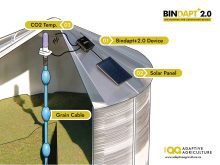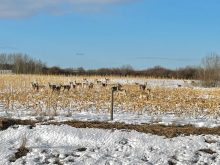“COOL just makes our plant that much more attractive.”
– Jim Ramsay
The chairman of the Saskatchewan Slaughter Plant Initiative says the group continues to move ahead with plans to construct a one-million-head-per-year hog slaughter plant to open by next fall.
“We know that the best time to start production is the fall, to open when the prices are right, so we’re anxious to get going by fall 2009,” said Jim Ramsay.
Ramsay is the project consultant for Fishing Lake First Nations, one partner in the Saskatchewan Slaughter Plant Initiative. Other partners include Big Sky Farms and the Saskatchewan Pork Development Board.
Read Also

Local farm businesses, groups look forward to Manitoba Ag Days 2026
Most of agriculture is seemingly at Manitoba Ag Days each January: Manitoba agribusinesses and farm groups look forward to connecting with farmers at the 2026 show.
Both the environmental and permit process for the eventual construction of the $100 million primary processing plant have been initiated at this point in time, according to Ramsay.
So far, the problems afflicting the financial sector have not been a problem for the group in terms of financing or accessing credit, he said. “Our plan was never to have this as a heavily debt-financed project. Our plan was to go primarily with equity,” Ramsay said.
He is optimistic that when the time rolls around for the group to begin looking for financing, much of the current credit woes will have been smoothed out.
COOL effects
Ramsay also said he remains confident that Saskatchewan is a good location for a primary hog processing facility.
The Sept. 30 implementation of mandatory country-of-origin labelling, or COOL, in the U. S., for instance, acts as a disincentive for Canadian hogs to be shipped into the U. S. for slaughtering, Ramsay said. “COOL just makes our plant that much more attractive,” he said.
Ramsay declined to discuss stories run in Saskatchewan newspapers in August, which quoted a provincial government official as saying that the Saskatchewan Party would not fund infrastructure for the plant.
“The provision of capital infrastructure to the project is something that we have always asked for and that is something that we would expect to be helped with, just like any other business,” was all that Ramsay said.
He emphas i zed that at no point in time did the Saskatchewan Slaughter Plant Initiative expect any level of government to put equity into the project.
Plans for the plant first took shape following Maple Leaf’s announcement that it would close its Saskatoon processing facility.
In the past, Ramsay has been quoted as saying that the group planned to begin construction of the plant by the spring of 2008.
He has also indicated that production at the kill and cut plant could eventually be ramped up from one million head per year to twice that amount with the addition of a double wshift.














